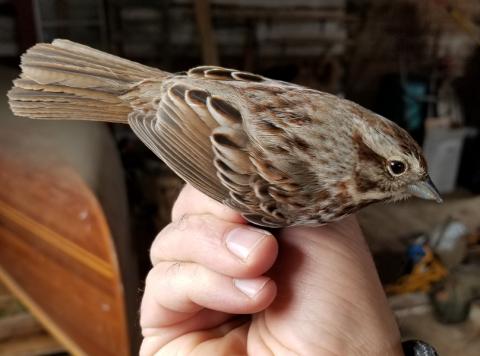A Bird in the Barn

On a grey day earlier this spring, when it still looked and felt more like winter, I went out to my barn to work on my chainsaw in anticipation of some spring cleanup. As I entered, I caught a movement out of the corner of my eye, and saw a bird fluttering in front of a window. It was frantically trying to get out, but was blocked by the window pane, and the bird must have been too panicked to notice me. Much to my surprise, I was able to quickly catch it, and holding its feet gently between my fingers, I took some quick pictures before setting it free.
The bird was about five to six inches long, mostly brown with a white breast spotted with dark brown to black markings. Suspecting it was a type of sparrow, I looked through the sparrow section in my copy of the National Audubon Field Guide to North American Birds, and noted that the song sparrow, Melospiza melodia, most resembled the one I caught. I asked a colleague who is far more knowledgeable about birds than I to confirm the species, and indeed it was a song sparrow. In addition to the markings, another characteristic described in guide books is pumping of the tail in flight.
According to the Audubon Field Guide, this bird is “probably the best known of our native sparrows”, and “is found almost everywhere in North America”. Not a rare find by any means, but a rare experience to be able to hold a live wild songbird in my hands for a moment.
Range, Habits, and Habitat
The song sparrow has a wide breeding range, from Alaska to Newfoundland, and from California across to North Dakota and as far south as the Carolinas. Winters are spent from southern Canada all the way down to the Gulf Coast and Mexico. Perhaps the bird in my barn was a local, having spent the relatively mild winter nearby.
Song sparrows occupy a wide range of habitats, including farm fields, overgrown pastures, the edges of freshwater marshes and lakes, forest edges, and in deciduous or mixed woods. Preferring to build their nests near the ground, any kind of dense shrubby habitat is suitable. The habitat around my house is perfect for song sparrows. There’s a small pasture behind my house, along with mixed young forest. Across the road is a mix of overgrown fields, hedgerows, open wetlands, and old beaver meadows.
The female song sparrow builds cup-shaped nest that is 4 to 8 inches in diameter, with the inside of the nest being about 2 to 2.5 inches across. The nest is built of grasses, weeds, and bark, and lined with grasses, fine roots, and animal hair. Once a nest is built, the female lays one to six blue, blue-green, or gray-green eggs with brown, red-brown, or lilac spots. The eggs are three-quarters to one inch long. The female can have up to seven broods in a season. This many broods is probably necessary due to susceptibility to predation; raccoons, fox, skunks, squirrels, house cats, snakes, and other predators probably account for many losses of eggs and young birds. Heavy predation is one of the drawbacks of being a ground nester.
Living in a variety of habitats, the song sparrow finds a wide range of foods to eat. Like most birds, it is omnivorous, and feeds on insects and other invertebrates as well as fruits and seeds. That’s another reason the bird is found in open, brushy habitats – openings get more sun than shady woods, and insects prefer warmer environments, so more insects are found in open areas. The same principle applies to berry producing shrubs. They tend to thrive where they can get plenty of sun.
Song Sparrows Are Common, But Other Birds Aren’t
Because the song sparrow is so common and widespread, it’s not considered a species of conservation concern. The habitat it prefers is also preferred by some birds that are of concern, however, so maintaining habitat that favors song sparrows will also favor those less common species. The New Hampshire Wildlife Action Plan lists the golden-winged warbler, field sparrow, and eastern towhee as some of the species of greatest conservation need (SGCN) that also use shrubby, young forest habitat. The Wildlife Action Plan defines Species of Greatest Conservation Need as species that are “in serious trouble – declining numbers, with smaller patches of habitat, and/or threatened by a host of issues”. The good news is that there are actions landowners can take to maintain and improve habitat for some of these species. It all starts with an assessment of the land regarding current habitats and features, and developing a plan of action for which habitats should be protected and which ones can be enhanced. UNH Cooperative Extension is a great place to get started.
Learn More
To learn more about songbirds and the NH Wildlife Action Plan, and how to care for wildlife habitat on your land, contact a UNH Cooperative Extension County Forester. We are available for site visits to your land to help you understand what resources you have to reach your goals for your land.
See www.nhwoods.org for more information on UNH Cooperative Extension.
Resources:
The Cornell Lab of Ornithology. All About Birds. Song Sparrow Life History. https://www.allaboutbirds.org/guide/Song_Sparrow/lifehistory
New Hampshire Wildlife Action Plan https://www.wildlife.nh.gov/wildlife-and-habitat/nh-wildlife-action-plan
Wildlife Management Institute. Young Forest Guide www.youngforest.org & www.wildlifemanagementinstitute.org
